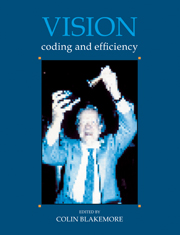Book contents
- Frontmatter
- Contents
- List of Contributors
- Preface
- Reply
- Acknowledgements
- Concepts of coding and efficiency
- Efficiency of the visual pathway
- Colour
- Brightness, adaptation and contrast
- Development of vision
- Depth and texture
- Motion
- From image to object
- 32 A theory about the functional role and synaptic mechanism of visual after-effects
- 33 Spatial and temporal summation in human vision
- 34 The efficiency of pictorial noise suppression in image processing
- 35 Algotecture of visual cortex
- 36 The iconic bottleneck and the tenuous link between early visual processing and perception
- 37 Pyramid algorithms for efficient vision
- 38 High level visual decision efficiencies
- Index
32 - A theory about the functional role and synaptic mechanism of visual after-effects
Published online by Cambridge University Press: 05 May 2010
- Frontmatter
- Contents
- List of Contributors
- Preface
- Reply
- Acknowledgements
- Concepts of coding and efficiency
- Efficiency of the visual pathway
- Colour
- Brightness, adaptation and contrast
- Development of vision
- Depth and texture
- Motion
- From image to object
- 32 A theory about the functional role and synaptic mechanism of visual after-effects
- 33 Spatial and temporal summation in human vision
- 34 The efficiency of pictorial noise suppression in image processing
- 35 Algotecture of visual cortex
- 36 The iconic bottleneck and the tenuous link between early visual processing and perception
- 37 Pyramid algorithms for efficient vision
- 38 High level visual decision efficiencies
- Index
Summary
Many striking visual illusions are caused by disturbances to the equilibrium of the visual system resulting from relatively short periods of intense activation; after-images fall into this category, as do motion and tilt after-effects. I am going to suggest a goal, or computational theory, for the equilibration mechanisms that are revealed by some of these illusions: I think they take account of the correlational structure of sensory messages, thereby making the system specially sensitive to new associations. The suspicious coincidences thus discovered are likely to signal new causal factors in the environment, so adaptation mechanisms of the kind suggested could provide the major advantageous feature of the sensory representations formed in the cortex.
Visual adaptation
The visual system changes its characteristics when the image it is handling alters. The simplest and best understood example is the change in sensitivity that occurs when the mean luminance increases or decreases, and it is now well recognised that this parallels the electronic engineer's automatic gain control. The idea was formulated by Craik (1938) and recordings from photoreceptors and bipolars in the retina show the system in operation (e.g. Werblin, 1973), though the exact parts played by the different elements are not yet clear. What is obvious, however, is that the retinal ganglion cells could not possibly be so sensitive to small increments and decrements of light if they had to signal the whole range of luminances the eye is exposed to without changing their response characteristics.
- Type
- Chapter
- Information
- VisionCoding and Efficiency, pp. 363 - 375Publisher: Cambridge University PressPrint publication year: 1991
- 25
- Cited by



